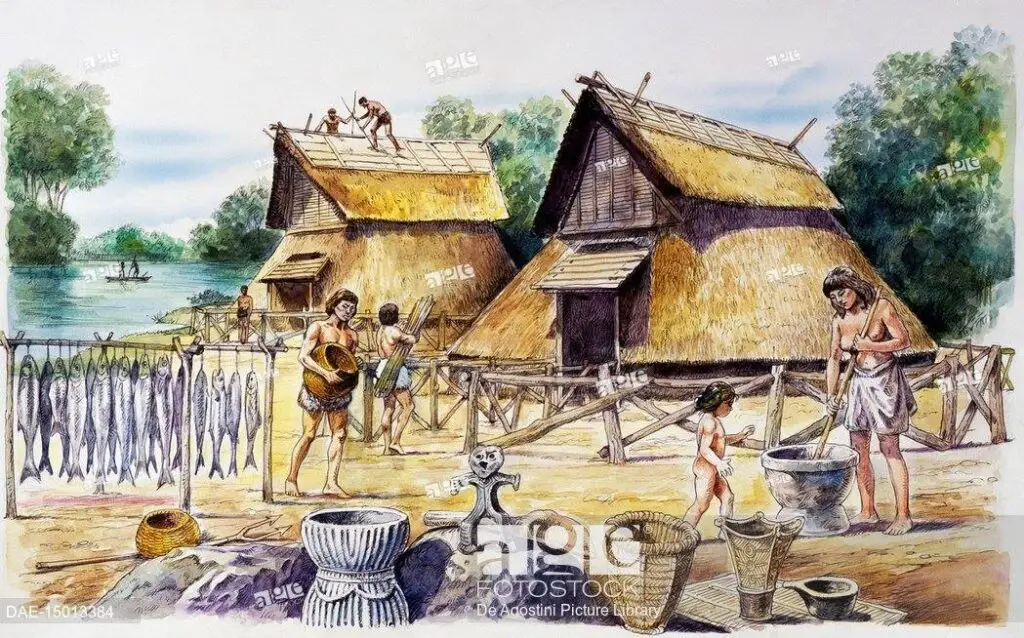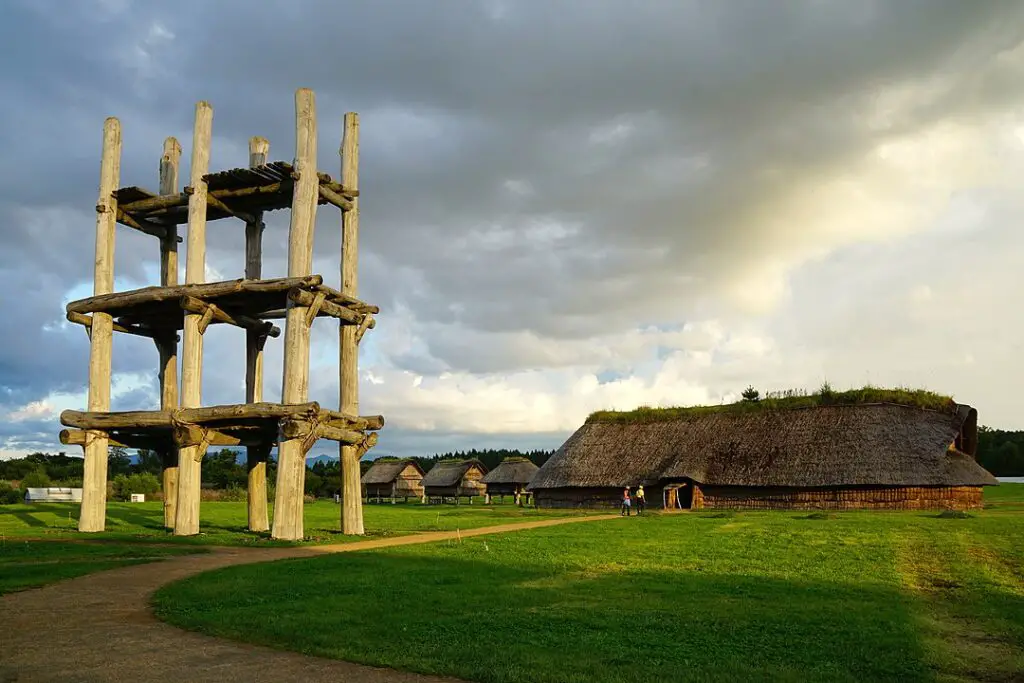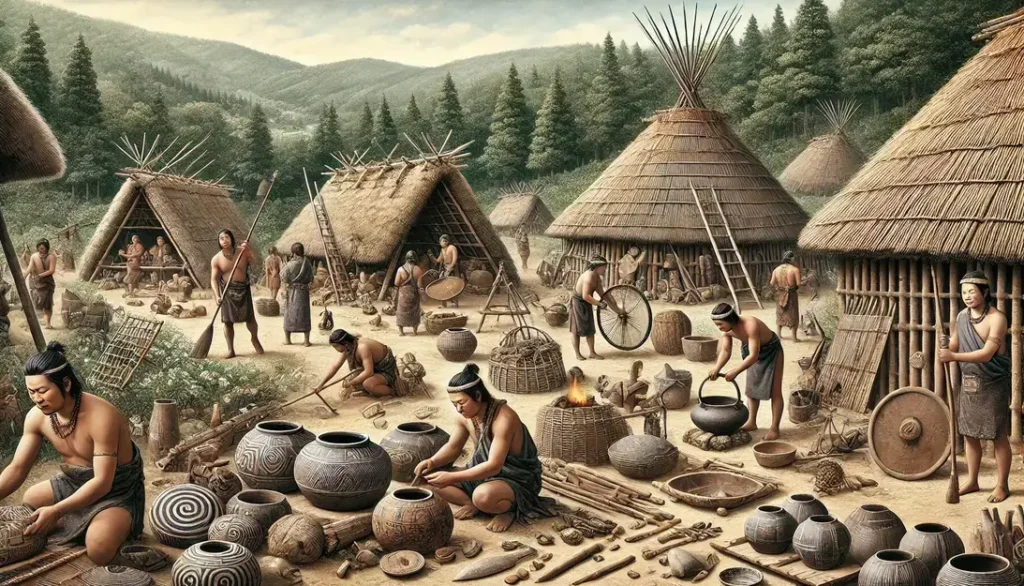The Jomon Period of Japan: A Fascinating Prehistoric Era

The Jomon Period is an important time in Japan’s history that lasted from about 14,000 BCE to 300 BCE. This time is known for its special pottery, early farming, and a unique culture of people who hunted and gathered food. The word “Jomon” means “cord-marked,” which describes the patterns on the pottery from this time. Learning about the Jomon Period helps us understand how Japanese society and culture started to develop.
The Jomon Period: Historical Overview
The Jomon Period is a very important time in the history of Japan. It started around 14,500 BCE and ended around 300 BCE. This period is divided into several phases, each with its own unique characteristics.
During the Incipient Jomon phase (13,750-8,500 BCE), people made the earliest known pottery in the world. Then comes the Initial Jomon (8,500–5,000 BCE), followed by the Early Jomon (5,000–3,520 BCE), the Middle Jomon (3,520–2,470 BCE), the Late Jomon (2,470–1,250 BCE), and finally the Final Jomon (1,250–500 BCE).
During these phases, the Jomon people developed from hunters and gatherers to settlers in villages. They made beautiful pottery, which is how the period got its name – ‘Jomon’ means ‘cord marked’ or ‘patterned’, which describes the style of pottery they made.

Geographical Context
During the Jomon Period, people lived in different regions of Japan, from the southern part of Hokkaido Island to northern Tohoku. These areas had a lot of natural resources like lakes, marshes, rivers, and forests. This made it a good place for the Jomon people to live and find food.
The geography of these regions influenced the Jomon culture in many ways. For example, the Jomon people used the clay from the ground to make pottery. They also used the wood from the forests to make tools and build houses. The rivers and lakes were a source of fish and other seafood.
So, the geography of the regions where the Jomon people lived played a big role in their way of life. It influenced what they ate, what they made, and how they lived. Even today, we can see the impact of this in the artifacts and sites from the Jomon Period that have been found in these regions.

Society and Social Structure
During the Jomon Period in Japan, clans and extended families formed the basis of communities. Dozens of residences sometimes made up these communities. The people stayed in the same location throughout the year, and they lived off the land by hunting, fishing, and gathering.
In these communities, both men and women had important roles. Men were often hunters and fishers, while women were gatherers and potters. Women also played a big role in family life. They took care of the children and the home, and they passed down important skills and traditions to the next generation.

Economic Activities
During the Jomon Period in Japan, people lived off the land by hunting and gathering. They hunted animals like deer and boar, and gathered food like nuts, berries, and fruits. They also fished and collected shellfish. This was their main way of getting food for a long time.
Even though they were mostly hunters and gatherers, the Jomon people also started to do some early agriculture. The first signs of farming appeared around 5700 BCE with slash-and-burn agriculture. They started farming specific areas of land from around 4000 BCE.
The Jomon people also did trade and exchange with other regions. They used dugout canoes to travel long distances and traded goods like jade, asphalt, and obsidian. This shows that they connected with other people and places and were not just isolated in their own communities.
Technology and Tools
During the Jomon Period in Japan, people made a lot of cool things using the resources they had. They made stone tools and implements for hunting and food processing. These tools included arrowheads, spears, and stone mortars. They also used stone tools to grind rocks, make knives, and axes.
One of the most amazing things they made was pottery and ceramics. They used clay to make pots and other containers. The pottery was decorated with patterns that looked like ropes, which is why it’s called ‘Jomon’, meaning ‘cord pattern’. This pottery is some of the oldest in the world!
The Jomon people were also very innovative in their tool making. They learned how to make strong containers by applying heat to the clay. They also made their tools better and more useful over time.

Housing and Architecture
During the Jomon Period in Japan, people lived in two main types of homes. They made one type of dwelling, a pit-type, by digging a shallow hole and covering it with a straw roof. The other was a circular dwelling, which had a round floor made from dried clay or stones, and it also had a roof.
The Jomon people used different ways to build their homes. They used wood from trees to make strong posts for the roofs. They also used clay to make the floors of their homes.
Where the Jomon people lived changed depending on the weather. When the weather was colder, they lived near the sea where they could find plenty of fish and shellfish. But when it was warmer, they moved inland to use the plants and animals there.

Art and Craftsmanship
During the Jomon Period in Japan, people created beautiful and unique art. One of the most famous types of art they made was pottery. They used clay to make pots and other containers. The pottery was decorated with patterns that looked like ropes, which is why it’s called ‘Jomon’, meaning ‘cord pattern’. This pottery is some of the oldest in the world.


The Jomon people also made jewelry and ornaments. They used materials like shells, stones, and bones to make earrings and other decorative items. They even used jade, which was a special stone that symbolized sincerity.
Art was very important in the daily life of the Jomon people. It was not just for decoration, but also had a deeper meaning. For example, the pottery they made was used for cooking and storing food. And the jewelry they wore could show their status or beliefs.
Spirituality and Beliefs
During the Jomon Period in Japan, people had a deep connection to nature and believed in animism. This is the belief that all things, including plants, animals, and even objects, have a spirit or soul. They also believed in deities, which were often associated with natural things like mountains, rivers, and forests.
The Jomon people also practiced shamanism and rituals. Shamanism is a type of religion where special people called shamans communicate with the spirit world. The Jomon people had many rituals and ceremonies, which were often led by a shaman. They used special tools and figurines in their rituals.
When it came to burial customs and practices, the Jomon people had unique ways of honoring their dead. They buried infants in large jars, and adults in pits and shell mounds near their villages. They also placed ceremonial offerings and other ornaments in the graves. These practices show that the Jomon people had a rich spiritual life and a deep respect for nature and the afterlife.

Epilogue
The Jomon Period was a fascinating time in Japan’s history. It lasted from around 14,500 BCE to 300 BCE. During this time, the Jomon people lived in harmony with nature. They were hunters and gatherers who used stone tools and made beautiful pottery. They lived in communities and had a rich culture that included art, rituals, and a deep respect for nature.
The legacy of the Jomon Period is still seen in Japan today. The pottery they made is some of the oldest in the world. Their respect for nature and their unique culture have influenced Japanese art, religion, and lifestyle. So, even though the Jomon Period was a long time ago, it continues to inspire and influence us today. It reminds us of the beauty of nature and the importance of living in harmony with it. That’s the enduring legacy of the Jomon Period.




